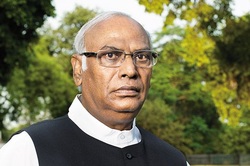
Mallikarjun Kharge
Age: 70
Designation: Railway minister
Career: Elected to the Karnataka State Assembly 10 times since 1972. Elected to the Lok Sabha in 2009 from Gulbarga.Now Hon'ble Railway Minister, Govt. of India.
Interests: Reading sports books, removing superstition
Q. India has set a target of skilling 50 crore young people by 2022. Do you think it is achievable?
A: While we have set the target to have a skilled workforce of 50 crore people by 2022, we have also set a mid-term target of skilling 5 crore people in the 12th plan period. I am sure that with the active involvement of all stakeholders, this is very much achievable.
Q. What are the preconditions to achieve this target? Do you think the current policies are good enough?
A: We would need active involvement of the states and the private sector in particular to achieve this target. We are trying to ensure that not only our policies but also our implementation system remains in tune with the time and delivers quality with scale.
Q. The quality of vocational training at the majority of institutes in India is poor and archaic. What is being done to improve it?
A: We have taken a lot of steps to improve the quality, including active involvement of the private sector, training of trainers, funding for upgradation of facilities etc. These efforts have started showing early results. We will scale up these efforts and take many more new steps to ensure that a majority of the candidates are able to find a job immediately after passing out.
Q. Except for the government giving money to vocational trainees, there is no institutional mechanism (bank loans etc) for funding students. Isn’t it possible to get the private sector involved in financing skill development?
A: This is not correct. The government has worked with the Indian Banks’ Association and a scheme for providing credit for vocational course has already been rolled out. A credit guarantee fund for the same is also being set up. Efforts are being made to mobilise private sector investments in various forms. We are proposing to set up a good number of ITIs (Industrial Training Institutes) and ATIs (Advanced Training Institutes) with active involvement of the private sector.
Q. There is a lot of emphasis on capacity building but not on placements. How do you solve this problem?
A: We are focusing on capacity building as well as placements. We realise that good placements alone will drive more youths to vocational training and therefore we are planning to take a variety of steps, including soft skilling of candidates, better information flow about jobs to candidates living in far-flung areas etc, to solve this problem.
Q. How do you bring more workers from the unorganised sector to the organised sector?
A: We need to upskill these workers as well as let them know about opportunities in the organised sector in an easy-to-access manner.
Q. There seem to be too many agencies—18 central ministries, NSDC, state governments—active in skill development. A lot of effort is duplicated. It was also one of the objections raised by your ministry during the inter-ministerial consultations on NSDA. How can this be streamlined?
A: We need to involve as many players as possible in skill development-related efforts and the task cut out for the country is huge and unprecedented. With the creation of the Cabinet Committee on Skill Development and the NSDA, we hope that things would be coordinated in a better way and we would be able to take all steps required for proper functioning of the skill development eco-system.
Q. Isn’t the labour ministry the right place to centralise skill development efforts? Why, for instance, should the finance ministry run a skill development scheme?
A: As indicated earlier, the job at hand is too large for any single ministry to handle. The finance ministry is not running any scheme directly, but only helping NSDC set up a much-needed quality training capacity on the private sector side.
Q. There are 1,436 MES (Manufacture Execution System) courses approved by the labour ministry. How many of these are actually active? Is it possible to get broken-down data on how many institutes run courses for each of these?
A: As you would agree, from the menu of such large number of MES courses, a few are likely to be more popular than others. There are around 8,000 VTPs (Vocational Training Providers) in the country today through whom these courses are being run. Given the huge potential this scheme can achieve, we are planning for a major revamp of the scheme in the next few months.
Q. How much money has the ministry spent on skill development since 2009 when the National Skill Development Policy was articulated? Can you give details of the funding in each of the 73 industry segments?
A: The ministry has many windows through which funds are spent for variety of purposes like creation and upgradation of training capacity, training of trainers, funding of per training cost etc. It is difficult to divide the money spent industry segment-wise; for example, as a welder can be absorbed in variety of industry segments.
Q. The Cabinet last month cleared setting up of the National Skill Development Agency, which was earlier proposed as an authority. Hasn’t it effectively rendered the NSDA toothless?
A: I don’t think so. Let us wait for the issue of a formal notification for setting up of the NSDA before writing it off.
Q. You had misgivings about the NSDA not being accountable to Parliament. What are your comments?
A: NSDA is proposed to be attached with the finance ministry, and thus would be fully accountable to the Parliament.
Q. Earlier this year, your ministry and the HRD ministry had clashed over the ownership of vocational qualifications framework. Why do such tussles happen?
A: There was no tussle but some differences in perceptions. We have amicably resolved it already
.
AGRICULTURE 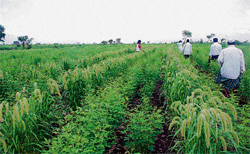 At a time when many parts of the State are reeling under drought, Honnalli village in Gulbarga district has shown the way. Farmers here have raised millets in spite of inadequate rainfall.
With shortage of rain, the State is reeling under severe drought. Farmers from several districts across the State are facing losses. Honnalli village in Gulbarga district seems to be insulated from this problem. This village in Aland taluk has taught important lessons to the rest of the State.
Farmers here are unperturbed by the drought that has affected other parts of the State because they have taken to millet farming, which neither uses chemical fertilisers nor pesticides.
Modern agriculture has meant that only hybrid crops are successful. Also, most farmers depend on chemical fertilisers and mechanisation. Often, in this process of modernisation, traditional crops have lost out. Millets, till not so recently, had very few takers with even scientists terming them as ‘coarse grain’!
However, the recent past has seen a revival of indigenous crops. Many farmers are growing and conserving traditional seeds. Farmers of Honnalli village have opted to grow millets, all thanks to the efforts of Deccan Development Society (DDS), an NGO based at Zaheerabad of Andhra Pradesh. This NGO has been striving to motivate farmers in the Gulbarga region to take up millet farming from the last 25 years. To take this movement forward in Karnataka, DDS decided to chalk out the ‘Siri Grama’ (millet village) scheme.
The Bayalu Seeme Rural Development Samsthe (BSRDS) took upon itself the responsibility of implementing the scheme.
After DDS conducted a survey in Honnalli to check for availability of millet seeds, a shocking fact came to light. Not a single type of millet seeds was available around the villages. Then, DDS distributed various varieties of millet seeds to farmers and they started to sow as soon as the monsoon started. After two-and-a-half months, the crops started to thrive.
“Two decades ago, farmers knew all about little millet, proso millet, foxtail millet and kodo millet varieties. They even cultivated these crops back then. But they slowly forgot these traditional crops because of non-availability of seeds. When we conducted a survey to look for farmers to raise millets, more than 50 people came forward to grow them again,” recalls BSRDS director Subbanna Biradar.
Though the region has received less rainfall, the crops have turned out fine. “It has been over 15 years since these crops were last raised here. Now we have managed to raise a successful crop,” says farmer Naganna Kori. Little millet and foxtail millet have been sown as mixed crops with red gram in Kalyanrao Patil’s field. Owing to water shortage, the area where red gram has been raised is shrinking, whereas the millet crops are thriving.
Another farmer Shivasharanappa says, “After sowing, we weeded the crops twice till now. The crops were attacked by neither pest nor disease.”
Seed bank
All the crops are in the harvesting stage now. According to an agreement between farmers and DDS, farmers should return double of the quantity of seeds once the harvesting is done! These seeds will be stored in a seed bank, which will be set up in the village itself. Farmers who want to grow millets may opt for seeds from the seed bank. To spread awareness about growing millets, a ‘field day’ was observed recently in a millet field of Honnalli. More than hundred farmers participated in this function.
“The production of nutritious food is decreasing along with loss of traditional crops.
People who are aware about health are opting for traditional crops. Millets are gaining popularity among consumers. Farmers must come forward to make use of this demand,” points out P V Satheesh, Director of DDS.
The success of the ‘millet village’ is an example for other farmers and villages on how to achieve self-reliance in the farming sector. Rather than pushing farmers into expensive farming methods, agriculture universities and research stations must come forward to learn the sustainable farming way.
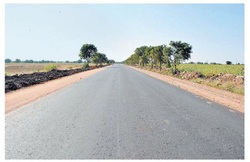 The upgraded inter-State highway constructed on the national highway standard connecting Maharashtra, Karnataka and Andhra Pradesh, near Sedam town in Gulbarga district of Karnataka
CHENNAI, OCT 15: Road projects with less traffic density, which are unviable on toll mode, may be executed through engineering, procurement and construction (EPC) contracts.
According to a high-power committee headed by HDFC Chairman Deepak Parekh, this will help speed up road construction projects in the country.
The conventional item rate contracts are prone to high cost and time overruns. The Planning Commission has formulated a model EPC contract that minimises time and cost overruns, the interim report of the High Level Committee on Financing Infrastructure of the Planning Commission.
This committee has members representing the Government, banking, insurance and infrastructure sectors.
EPC contracts for 5,000 km may be awarded during this fiscal , the panel has recommended.
Projects awarded by the National Highways Authority of India (NHAI) have fallen short of targets during the past several years due to delays in the bid process.
The award of such projects also tends to be bunched up during the last two months of the financial year.
The NHAI should draw up a month-wise plan to award 10,000 km in 2012-13.
The programme should be placed in the public domain and progress should be updated each month, the committee said.
IMPLEMENTATION DELAYSMajor constraints affecting the road development programme include implementation delays and lack of capacity within NHAI to re-orient itself from conventional contracts to the public-private-partnership discipline.
The committee recommended that institutional restructuring of NHAI should be completed within a specified time-frame, as already approved by the Cabinet.
The total investment for the road sector is projected at Rs 9.20 lakh crore during the Twelfth Plan, of which the Central and States’ share would be Rs 3.58 lakh crore and Rs 2.66 lakh crore, respectively, accounting for about 68 per cent of the total investment.
The private sector is projected to account for 32 per cent or Rs 2.94 lakh crore of the total investment, the report said.
During the Eleventh Plan, against a target of 1,000 km of expressways, no progress could be made.
The expressway programme may be rolled out expeditiously and the long-awaited Expressway Authority of India may be constituted to provide an impetus to the Expressway programme, the Parekh-led panel recommended .
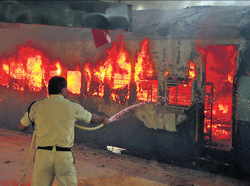 The authorities are yet to establish the cause of the fire that ravaged a bogie of the Gulbarga-Solapur passenger train stationed at the platform number 3 of the railway station here on Tuesday. The accident charred two people to death, and inflicted four others with burns.
Surviving passengers told police that they had had heard a loud explosion which was followed by thick smoke and fire.
One passenger, Naseem Banu, who was going to Solapur for medical treatment, said that he saw a saw a trickle of fuel just before the explossion. “I was eating lunch and suddenly I saw a trickle of kerosene oil below my seat. Before I could realise what was happening, I heard a huge explosion and rushed out of the coach,” he said.
Another passenger, Gopal Guttedar said that about five boys were moving in the coach suspiciously, closing all the windows and doors of the coach — just moments before the explosion.
When the fire engulfed the entire coach. Guttedar threw his grandson out, to safety and pushed his wife through the window before following her out. Fortunately, the window did not have a grill.
Suresh, a passenger bound for Barutgi in Maharashatra said that, “I was reading a newspaper, when I suddenly I heard an explosion followed by smoke and fire. I pushed two children out from the door before I got out myself.’’
He said some railway policemen made vain attempts to put out the fire using two fire extinguishers in the bogey, but proved unable to operate the equipment.
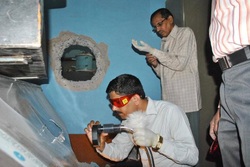 In a daring theft, burglars entered the State Bank of India (SBI) branch at Kadaganchi village in Aland taluk in Gulbarga district in the early hours of Saturday and decamped with cash and gold ornaments worth over Rs. 1.52 crore from the secured lockers in the strongroom of the bank.
Senior police officials were baffled by the ingenuity of the burglars. According to preliminary estimates, the bank was looted of Rs. 46 lakh cash, and gold ornaments worth over Rs. 1.06 crore. Bank officials were still in the process of taking stock of the exact loss.
The burglars gained entry into the bank from the unguarded backdoor. They first broke open the lock of the mild-steel collapsible gate and then the wooden backdoor. A hole was drilled in the wall to enter the strongroom where the cash was kept in the heavily secured chests, and the gold ornaments in lockers.
Tools used
Police officials, who inspected the spot, said the burglars had used cutters and other tools to prise open the cash chests and lockers. They appeared to have full knowledge of the location of the strongroom, how the security system worked, and also where the CCTV cameras were installed. The burglars entered the bank, disconnected the power supply to the alarm system and smashed all the three CCTV cameras inside. Before smashing the cameras, the burglars flashed the torchlight directly on to them to prevent their images of the burglars.
Fortunately for the police, one camera captured a few images.
Forensic experts have collected fingerprints from the scene of the crime.
The buglary was noticed only when the branch opened in the morning. The branch is located on the outskirts of the village with only a few shops adjacent to it. Inspector-General of Police Mohammad Wazir Ahmed and other senior police officials visited the spot.
The police suspect the involvement of professional burglars from neighbouring States.
MUMBAI: The Shivaji Nagar police arrested an agent who promised to send people to Saudi Arabia as khadim (helper) during the Haj this year. The accused, Saleem Usman Shaikh, collected Rs 5,000 each from more than 2,000 people and lured them with a free trip to Mecca and a monthly salary of Rs 16,000. Additional commissioner of police Qauiser Khalid said, "We received complaints from a group of social activists in the second week of September. The victims told the police that Shaikh had promised them a free trip to Mecca and charged Rs 5,000 each for medical examination. He had told many people that their flights were scheduled to leave for Jeddah on September 23. However, he shut his office and escaped on September 11. We traced him at Shivaji Nagar and charged him with cheating." Two days ago the police said two youths who had come in an auto with three bags left it saying it was for one 'Saleembhai'. The bags were later given to the police who found 1,468 passports lying in them. The passports belonged to people from Maharashtra, Karnataka and AP. Khalid said one more case has been registered against Shaikh in a Gulbarga police station. "We found 350 passports belonging to people from Gulbarga and 280 from various parts of AP," said Khalid. Sources said that it was not just Rs 5,000 medical fee. "The accused person had given the contract for bringing clients to other agents and sub-agents. Many sub-agents charged between Rs 7,000 and Rs 25,000 per person," sources said. "The fraud is much bigger than what has been mentioned in the police record," said an observer. The scam, say sources, if probed properly many layers of agents and sub-agents, who cheat people every year in the name of the holy journey, will be exposed. On an average, Haj journeyfor an Indian costs around Rs 1.5 lakh. The Khadims who are sent by various recruiting agencies to help Haj pilgrims generally pay between Rs 25,000 and Rs 40,000 per head for four months. However, no salary is given to them.
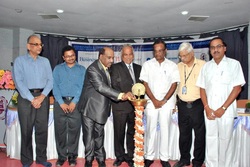 GULBARGA, OCT. 7:
A leading farm educationist has said that the Government should draw up a robust pricing policy for agriculture produce.
Dr B. T. Pujari, Dean (Agriculture), University of Agriculture Sciences, Raichur, said crop holidays is a dangerous trend and the Government should ensure proper pricing policy for farm produce. He said stabilisation of the market is a crucial factor for sustainable agriculture.
Dr Pujari was speaking at the ‘Hedgers and Prospective Hedgers Awareness and Education Seminar on Agriculture Business and Commodities Price Risk Management’ jointly organised by The Hindu Business Line, National Commodity and Derivatives Exchange (NCDEX), Federation of Karnataka Chamber of Commerce and Industry, Hyderabad, Karnataka Chamber of Commerce and Industry, and State Bank of Mysore, here on Friday.
Dr Pujari said to ensure food security to the ever-growing population, it has become imperative for the Government to tread cautiously on its EXIM policy as far as agriculture commodities are concerned.
EXPORT, IMPORT POLICIESHe said the export and import policies of the agriculture commodities should be under the Agriculture Ministry, and the import and export of agriculture commodities should be based on supply and demand.
Lauding the intervention of the NCDEX in the market in Gulbarga in the past two years, Dr Pujari said the entry of NCDEX in the market has helped stabilise the prices of red gram .
G. Chandrasekhar of The Hindu Business Line in his presentation stressed the importance of achieving at least 4 per cent growth in the agriculture sector to achieve 9 per cent GDP growth during the 12th Plan period.
“We will not be able to lift the people out of poverty unless we achieve a 4 per cent growth in agriculture sector….our growth in agriculture field had remained constant at 2.5 per cent, which was not sufficient to push the country forward in the path of development.”
He blamed the lopsided policies for the slow growth rate of agriculture sector and said the present policies are not growth oriented and do not give stress on agriculture development, irrigation development and improving rural infrastructures.
He said agriculture should become a source of strength and not a burden and planners should use the information technology, biotechnology, nuclear technology and nano technology to help agriculture to achieve the much-desired growth rate. The Deputy Manager of NCDEX, Deepak Sayana, in his presentation, gave an insight into the functioning of the spot, future and forward markets, and how it helps farmers get better prices for their produce.
The business in the agriculture futures market has witnessed a record growth from Rs 5.71 lakh crore in 2004 to Rs 119.48 lakh crore in 2010-11.
 Gulbarga (Karnataka), Sep 29 (IANS): Unseeded Prerna Bhambri capped her fine run by defeating fourth seed Zi Yang of China 6-2, 6-2, in the final of the $10,000 ITF Gulbarga Open Women's Futures tennis championship here Saturday.
In the final lasting over an hour, Prerna with a dominant display, outplayed Yang who struggled to get going in the match.
Yang, who sparkled in the second set, however, made lot of unforced errors and failed to stay in the hunt while Prerna showcased her all-round game for a deserving victory.
In the doubles final Friday evening, Hae-Sung Kim and Ju-Eun Kim beat Pei-Chi Lee and Chia Hsien Yang 6-1, 6-1.
Gulbarga: Unseeded Prerna Bhambri and fourth seed Zi Yang of China set up a title clash with resounding wins in the semi-final of the $10,000 ITF Gulbarga Open women`s Futures tennis championship here Friday.
Prerna, ranked 803 in the world, outplayed the 970th ranked Nan Nan Zhang of China 6-2, 6-2 in 76 minutes. Zi Yang (590) routed top seed Wing Yau Venise Chan of Hong Kong (371) 6-0, 6-0 in 48 minutes.
"I played my natural game but the match was easier than expected," said Prerna, the 20-year-old from Delhi who did not allow Zhang to engage in any prolonged rallies and kept looking for the right openings to come up with winners with her strong forehand.
Prerna kept Zhang on the move all the time with her deep and angled placements. The Chinese, who often struggled with her first serve, failed to break even once.
Prerna broke her rival in the third and seventh games for the first set, and had two more service breaks in the second to wrap up the match.
 Gulbarga: A gritty Prerna Bhambri clawed her way into the semis of the US$10,000 ITF Gulbarga Open women`s futures tennis championship at the expense of injured Emily Webley Smith of Great Britain here at the Dr. Chandrashekar Patil Stadium Thursday.
Seeded second, Emily, who lost the first set 5-7 and led 2-1 in the second, twisted her ankle while going for a return from baseline.
The Brit sought a medical timeout and got back into action but could hardly move and conceded the match to Prerna.
The first set was marked by back-to-back breaks. Prerna stayed afloat with her steady returns while Emily struggled with her first serve.
Prerna held herself for a 6-5 lead and broke Emily decisively in the twelfth game to take the set.
Rushmi Chakravarthi`s campaign also came to an end as she lost to her Chinese rival Nan Nan Zhang 6-7(2), 0-6 in the quarters.
The two traded breaks in the first two games and Rushmi had a great chance when she went 5-4 up with another break in the ninth game.
But the set went into a tie breaker and Zhang dominated the show as Rushmi netted thrice in a row to trail 2-5 and ultimately lost 2-7.
The second set was a whitewash as a resurgent Zhang simply out-hit her rival and won 6-0.
Chinese fourth seed Zi Yang also cruised into the semis with 6-1, 6-0 victory over wild card Vaishnavi Peddi Reddy.
Hard-hitting Ukranian teenager Oleksandra Korashivilli gave a torrid time to top seed Wang Yau Venise Chan with some aggressive tennis before going down 6-2, 6-7(0), 6-7(3).
Oleksandra, 16, set the pace in the first set winning 6-2 with two successive breaks in fifth and seventh games, respectively.
But Chan hit back in the second set to lead 5-2 before Oleksandra rallied to make it 5-all.
In the tie-breaker, the Ukranian girl`s errors proved costly and dropped it without taking a point.
In the decider, Chan led 5-1 before Oleksandra battled to level at 5-all.
The 16-year-old then lost the tie-breaker 3-7.
In Friday`s semifinals, top seed Chan meets the fourth seed Zi Yang while Prerna Bhambri meets Nan Nan Zhang of China.
Quarterfinal results:
Prerna Bhambri bt Emily Webley Smith 7-5, 2-1 retired; Nan Nan Zhang bt Rushmi Chakravarthi 7-6(2), 6-0; Zi Yang bt Vaishnavi Peddi Reddy 6-1, 6-0; Wang Yau Venise Chan bt Oleksandra Korashivilli 2-6, 7-6(0), 7-6(3).
IANS
|








 RSS Feed
RSS Feed